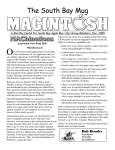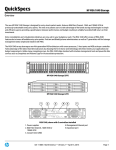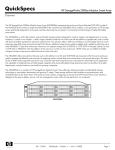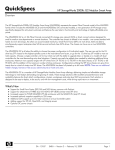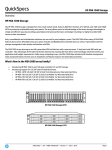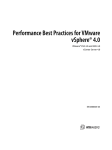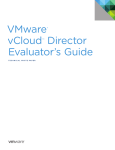Download VMware vCenter Chargeback
Transcript
VMware Technical Support Guide February 2010 ® Thank you for using VMware products and services. Technical support is a vital part of the total VMware customer experience. We want you to get the most from our products long after the initial sale and installation. We are dedicated to ensur ing that every issue is resolved to your satisfaction. To enable you to maximize the return on your investment, we offer a suite of support offerings designed to meet your business needs. This document provides an overview of the VMware Support offerings and how to use them. Contents Building an Effective Support Relationship…………..…………………………………………………………………………………………….5 Roles and Responsibilities .................................................................................................................... 1 Customer Roles and Responsibilities .................................................................................... 1 Support Administrator........................................................................................................... 1 Primary and Secondary License Administrators .................................................................... 1 VMware Support Roles and Responsibilities ........................................................................................ 1 Customer Service Representative ......................................................................................... 1 Best Practices ........................................................................................................................................... 3 Educate Your Administrators ................................................................................................................ 3 Plan Ahead ........................................................................................................................................... 3 Assign Appropriate Resources ............................................................................................................. 3 Utilize Self-Help .................................................................................................................................... 3 Provide Complete and Accurate Information ........................................................................................ 3 Keep your Profile Up-to-Date ................................................................................................................ 4 Register your Products ......................................................................................................... 4 Support Request Life Cycle ...................................................................................................................... 4 Before You Begin – Create your Profile and Register your Product ..................................................... 4 Serial Number or Licensing Activation Code Errors ................................................................................ 10 Collecting Information ............................................................................................................................. 11 Configurations .................................................................................................................................... 11 Log File ............................................................................................................................................... 11 Support Script Output ......................................................................................................................... 11 Record Any Recent Changes ............................................................................................................. 11 Utilizing Self Help Tools ...................................................................................................................... 11 Documentation.................................................................................................................................... 12 Technical Resources .......................................................................................................................... 12 Developer Resources ......................................................................................................................... 12 Knowledge Base ................................................................................................................................. 12 Discussion Forums ............................................................................................................................. 12 User Groups (VMUGs) ....................................................................................................................... 12 Compatibility Guides ........................................................................................................................... 12 Understanding Severities ........................................................................................................................ 12 Submitting a Support Request ................................................................................................................ 13 File a Support Request Online ............................................................................................................ 13 Pre-Paid Per Incident Support – ......................................................................................................... 17 File a Support Request By Phone....................................................................................................... 19 Working the Problem .......................................................................................................................... 20 Escalating a Support Request ............................................................................................................ 21 What steps do I take to escalate? ....................................................................................................... 22 What happens once I request an escalation? ..................................................................................... 22 How often can I expect updates on an escalation?............................................................................. 23 TECHNICAL SUPPORT GUIDE– FEBRURARY 2010 / I Can VMware engage other vendors if required? ................................................................................ 23 What can I do if I don’t feel progress is being made with an escalation? ............................................ 24 How do I de-escalate a support request? ........................................................................................... 24 Support Request Closure ....................................................................................................................... 24 Resolution of Bug-Related Support Requests .................................................................................... 24 Customer Satisfaction Surveys ........................................................................................................... 24 Support Policies .................................................................................................................................. 25 Third-Party Hardware/Software Support ............................................................................................. 25 Software in the Service Console technical note .................................................................................. 25 Support for Microsoft Software in VMware Virtual Machines .............................................................. 25 Local Language Support Policy .......................................................................................................... 26 Defect Report ..................................................................................................................................... 26 SDK Support Policy ............................................................................................................................ 27 API Support Policy .............................................................................................................................. 27 VMware Open Source Support Policy ................................................................................................ 27 Evaluation User Support Policy .......................................................................................................... 27 Experimental Feature Support Definition ............................................................................................ 27 After-Hours Support ............................................................................................................................ 28 Feature Requests ............................................................................................................................... 28 Security Response Policy ................................................................................................................... 28 Appendix A: Support Offerings Portfolio ............................................................................... 29 TECHNICAL SUPPORT GUIDE– FEBRURARY 2010 / II VMware Technical Support Guide Introduction Building an Effective Support Relationship The effectiveness of any support interaction depends upon the technical knowledge, problem solving skills and communication skills of both your administrators and our Technical Support Engineers (TSE). In addition, a good understanding by both par ties of their roles and responsibilities is crucial to effective communication. In order to ensure that your experience with VMware Technical Support is as effective and efficient as possible, we would like to define these roles and share some best practices that can accelerate the problem-solving process and enhance your customer service experience. Roles and Responsibilities Customer Roles and Responsibilities VMware can work more effectively with your organization by collaborating with a regular set of contacts for technical as well as contractual issues. We define two types of customer contacts for every agreement: Support Administrator Support administrators are responsible for submitting support requests and working with VMware Support representatives. The level of support you choose determines the number of individuals that can be designated as support administrators. If a designated support administrator changes, a request must come from your primary license administrator to make this change. For complimentary support, only the customer to whom the product is registered can submit support requests. Primary and Secondary License Administrators License administrators are responsible for receiving and administering software product licenses, updates and upgrades from VMware and operate as the point of contact for renewing support agreements. Primary license administrators can go online and add, edit or remove support or license administrators tied to existing contracts. A flash demo can be found online and an FAQ is available to assist your primary license administrator with this process. VMware Support Roles and Responsibilities There are two types of support professionals working in th e VMware Support organization. Your understanding of which group you are talking to, and what their responsibilities are, goes a long way to minimize any frustration. Customer Service Representative These individuals are your first contact when submitting a support request by phone. Their responsibilities include, but are not limited to: Accurately and thoroughly logging your support requests into our call tracking system Giving you the tracking number used to identify your support request Setting appropriate expectations regarding initial response times based on your support agreement Creating and/or maintaining accurate customer profiles TECHNICAL SUPPORT GUIDE– FEBRURARY 2010 / 1 VMware Technical Support Guide Technical Support Engineer Your support requests are assigned to a TSE. The TSE is your main contact for providing technical support and guidance. Their responsibilities include, but are not limited to: Responding to support requests, primarily via email and telephone Recreating customer technical environments Researching, identifying, and resolving a variety of issues Working with other VMware departments to resolve issues TECHNICAL SUPPORT GUIDE– FEBRURARY 2010 / 2 VMware Technical Support Guide Best Practices Based on our experience in supporting enterprise-class customers with virtualization infrastructures, we would like to share with you some recommendations and best practices for a highly effective support relationship. Educate Your Administrators We have found that customers who invest in VMware education courses for their administrators are much more effective in defining the symptoms of problems and in working with us to resolve the underlying issues. The return on this investment is almost immediate when you consider the cost of the education versus the cost of downtime. The VMware Certified Professional (VCP) program offers technology professionals the knowledge, skills and credentials to deploy and maintain VMware virtualization technology. Plan Ahead Before deploying our products, it is beneficial to review VMware release notes and other related technical documentation for your environment. Of particular interest are the installation, configuration and running of guest operating systems. We also recommend that you carefully define your project plans and include adequate test time and a “crisis” plan to ensure your administrators know how to contact the vendors involved. For more compl ex infrastructure changes, VMware offers a variety of consulting services, including the VMware Virtual Infrastructure Methodology (VIM), to help you assess your existing systems and applications, and then use that knowledge to plan, build and manage your virtual infrastructure. Assign Appropriate Resources Individuals assigned to deploy VMware products should be experienced in the installation, operation, and maintenance of the hardware, desktop, server, network operating systems, and applications in your environment before installing VMware software. Many installation issues are actually issues with third party components and software. These issues would exist regardless of whether you were installing on a physical machine or a virtual machine. If you require assistance, VMware consultants are available to identify the best solution for your environment, develop the solution and implement it right the first time. Utilize Self-Help Organizations can take full advantage of VMware self -help tools available on the Web. From our support home page, you can find links to technical documentation and knowledge base solutions, discuss issues with other administrators in our discussion forum, and reference our white papers, tech notes and compatibility guides. Provide Complete and Accurate Information As with any troubleshooting process, accurate and timely resolution depends on accurate and timely information. If a virtual machine exhibits abnormalities or crashes, please run the “vmsupport script” to collect the appropriate log files and system information. Information on how to run this script for the various platforms can be found in the following knowledge base article, http://kb.vmware.com/kb/1008524. Create a personal profile. If you are new to VMware Support, you need to create a personal profile and register your product serial numbers via the VMware Web site. TECHNICAL SUPPORT GUIDE– FEBRURARY 2010 / 3 VMware Technical Support Guide Keep your Profile Up-to-Date We encourage you to create and maintain your profile information. You should register immediately after product purchase. This minimizes some of the overhead in processing your support request and allows us to respond to your support requests quickly and effectively. Register your Products Product registration is key to associating your support agreement with the correct product. Until you officially register the product, there may be some delays in processing your support request. Support Request Life Cycle When a technical issue with your product arises, the VMware Technical Support team is here to help. Whether you contact VMware by phone or the Web, your support request is promptly logged and your issue quickly assigned to the appropriate TSE. The following sections detail the life cycle of a support request. Before You Begin – Create your Profile and Register your Product 1. Go to www.vmware.com. 2. Select Account in the top right hand corner of the web page. TECHNICAL SUPPORT GUIDE– FEBRURARY 2010 / 4 VMware Technical Support Guide 3. If you are a New Customer, go to step 4 below. Otherwise, select the Register a Product link and proceed to step 8. 4. If you are a new customer, select Register Now. TECHNICAL SUPPORT GUIDE– FEBRURARY 2010 / 5 VMware Technical Support Guide 5. Fill out all required fields. If your software purchase is for personal use: In the Company/Name field, type “personal” In the Department field, select “other” TECHNICAL SUPPORT GUIDE– FEBRURARY 2010 / 6 VMware Technical Support Guide 6. Once your profile has been created, click the “Account” link to get back to the Account Home page. TECHNICAL SUPPORT GUIDE– FEBRURARY 2010 / 7 VMware Technical Support Guide 7. Then click “Register a Product” to register your product. TECHNICAL SUPPORT GUIDE– FEBRURARY 2010 / 8 VMware Technical Support Guide 8. Type your serial number or license activation code exactly as it is written. Note: In all cases "0" is the digit zero and not the letter "O". TECHNICAL SUPPORT GUIDE– FEBRURARY 2010 / 9 VMware Technical Support Guide 9. Once the form is complete, select Continue. You can now create a support request. For detailed information on how to create a support request, please click here. Serial Number or Licensing Activation Code Errors If you receive an error message when trying to register your serial number or license, please contact our Licensing department or contact VMware at U.S. and Canada: 1-877-4VMWARE (1-877-486-9273) or 1-650-475-5345 Global toll free numbers are provided at http://www.vmware.com/support/phone_support.html. TECHNICAL SUPPORT GUIDE– FEBRURARY 2010 / 10 VMware Technical Support Guide Collecting Information These guidelines describe the information VMware needs diagnose issues and quickly log your support request. Please gather the pertinent information before you contact VMware Support. Configurations System, storage and/or network configuration diagrams and files are very helpful when troubleshooting issues with a VMware product. Having these diagrams on file for easy upload to VMware Support or running the appropriate commands on the devices to collect the configuration information will help speed up the problem-solving process. Log File If you are reporting an issue you encountered while installing a VMware product, it is helpful to have your installation log file. Please locate and provide the VMware log file and a VMware core file if the log indicates that one was created. The location of the log files is dependent on the operating system and VMware product you are using. Please refer to the appropriate VMware Administrator documentation for the specific syntax. If the physical hardware is crashing, any log files from the hardware vendor can be helpful as well. Support Script Output If a virtual machine exits abnormally or crashes, reboot it and run the support script to collect the appropriate log files and system information. The syntax and location of t he script vary for different VMware platforms. Please refer to the following knowledge base article for gathering troubleshooting data for Technical Support to review, http://kb.vmware.com/kb/1008524. Record Any Recent Changes Check to see if any changes have recently occurred in your virtual infrastructure environment. Changes to versions of guest operating system, host operating system, networking, storage and applications are of particular interest. Utilizing Self Help Tools Purchasers of VMware products can register for access to VMware Communities. VMware Communities provide resources and services for members, including full product documentation, technical papers, developer resources, access to the VMware Support knowledge base, participation in discussion forums, information about VMware user groups and a monthly technical newsletter for end-users of VMware products. Many of these same resources can be linked to from our support home page. VMware continually updates these resources with new technical information, fixes, and workarounds. Included is a convenient search of these resources for existing answers to your questions at the start of the support request filing process. The goal is to provide immediate answers to the most common customer questions. TECHNICAL SUPPORT GUIDE– FEBRURARY 2010 / 11 VMware Technical Support Guide Customers can also sign up to receive alerts on patches and maintenance releases as they become available. Documentation All customers have unlimited access to Web-based technical documentation for all VMware products at http://www.vmware.com/support/pubs/. This information includes product documentation and release notes for all currently released VMware products. Technical Resources White papers, technical notes, compatibility guides and other technical information for all currently released VMware products can be found at http://www.vmware.com/support/pubs/. Developer Resources For developers wishing to incorporate virtual infrastructure services into their programs, VMware provides the VMware vSphere Web Services SDK. The SDK consists of the VMware vCenter Server (formerly VirtualCenter Server) Web Service interface and a development kit containing a WSDL file, documentation and sample code. The VMware vSphere Web Services SDK package and support policy can be found at http://www.vmware.com/support/developer/. Knowledge Base You can browse or search the VMware Support knowledge base for troubleshooting information for all released VMware products at http://www.vmware.com/support/kb. Discussion Forums Share information and experiences with other users of VMware products by registering and participating in the Discussion Forums at http://www.vmware.com/community/. User Groups (VMUGs) The VMware User Group (VMUG) program is designed to encourage and support communities of VMware users who want to hold regular meetings in their local area. The purpose of thes e gatherings is to provide a forum in which VMware users can share best practices and expertise, and VMware can in turn obtain feedback from the user community. To find a VMUG in your area, please visit: http://www.vmware.com/vcommunity/usergroups.html. Compatibility Guides You can check to see if there are any known system, I/O, SAN or backup compatibility issues and which guest operating systems are supported by visiting our Web site at http://www.vmware.com/resources/guides.html. Understanding Severities Severity level is a measure of the relative impact of an issue on your systems or business. Accurately defining the severity of your issue ensures a timely response and helps VMware to understand the nature of your issue. Severity 1 means your production server or other mission critical system(s) are down and no workaround is immediately available. TECHNICAL SUPPORT GUIDE– FEBRURARY 2010 / 12 VMware Technical Support Guide All or a substantial portion of your mission critical data is at a significant risk of loss or corruption. You have had a substantial loss of service. Your business operations have been severely disrupted. Severity 1 support requires you to have dedicated resources available to work on the issue on an ongoing basis during your contractual hours. Severity 2 occurs when a major functionality is severely impaired Operations can continue in a restricted fashion, although long-term productivity might be adversely affected. A major milestone is at risk. Ongoing and incremental installations are affected. A temporary workaround is available. Severity 3 involves partial, non-critical loss of functionality of the software Impaired operations of some components, but allows the user to continue using the software. Initial installation milestones are at minimal risk. Severity 4 refers to general usage questions Cosmetic issues, including errors in the documentation. Submitting a Support Request VMware Support Services can be accessed from the VMware Web si te or by phone. Access varies by license type, support offering (contract or per incident) and product. File a support request online – available if you have purchased a support contract, Per Incident Support pack, or product that qualifies for complimentary support. File a support request over the phone – available if you have purchased a Production, Basic or Desktop Standard support contract or if you have purchased a Per Incident Support Pack for a qualifying product. File a Support Request Online Filing a support request online is available to all customers covered by one of our sup port contracts or by the purchase of a pre-paid support incident. TECHNICAL SUPPORT GUIDE– FEBRURARY 2010 / 13 VMware Technical Support Guide 1) Go to www.vmware.com/support and select "Create Support Request." TECHNICAL SUPPORT GUIDE– FEBRURARY 2010 / 14 VMware Technical Support Guide 2) Before you submit a support request, you will have the option to search the knowledge base, which may offer an immediate answer to your question or issue. 3) If you do not find the answer you are looking for, continue on to file a support request by selecting "log in and submit a Support Request immediately." TECHNICAL SUPPORT GUIDE– FEBRURARY 2010 / 15 VMware Technical Support Guide 4) Enter your email address and password from your VMware profile. If you do not have a profile, you will need to create one and register your products to activate your support agreements. TECHNICAL SUPPORT GUIDE– FEBRURARY 2010 / 16 VMware Technical Support Guide 5) If you have active contracts, you will be presented with a list of products, support agreement contracts and product versions in a table on t he screen. An example is included below. (The exact products and support levels shown will depend on your purchases, registrations and agreements.) Select one of the products in the right hand "Click for Support" column to access the Online Support form. Pre-Paid Per Incident Support Note: if you have purchased per incident support for specific products, these pre-paid support incidents appear in another table that you access by selecting Support Tools and then choosing "View Any Pending Pre-Paid Support Requests." You may be required to login again. An example is included below. (The exact products will depend on your purchases and registrations.) Select one of the products in the right hand "Request Support" column to access the Online Support form. TECHNICAL SUPPORT GUIDE– FEBRURARY 2010 / 17 VMware Technical Support Guide 6) Fill out the necessary fields, provide a detailed problem description and attach any/all configuration, log and core files (as appropriate). Depending on the product's support entitlement, this form may not include all of these fields. TECHNICAL SUPPORT GUIDE– FEBRURARY 2010 / 18 VMware Technical Support Guide After you fill out the support request form, your request is assigned a support request number. The support request number is confirmed with you on-screen and a computer-generated message acknowledging receipt of your support request will be sent within one hour. Please use this support request number when communicating with VMware about that specific issue. If you do not receive an electronic response from us within one hour, please send an inquiry to Customer Service. Initial response times from a TSE will follow the guidelines for your specific support offering. Response will be by phone, or email, or a combination of both, depending on the support offering and/or your preferred method of contact as specified when creating your support request, license type, support offering (contract or per incident) and product. File a Support Request By Phone VMware technical phone support is available to customers covered by Production (24x7), Basic (12x5) or Desktop Standard support contracts or a Per Incident Support Pack for a qualifying product. The main numbers for VMware Technical Support are: U.S. and Canada: 1-877-4VMWARE (1-877-486-9273) or 1-650-475-5345 Global toll free numbers are provided at http://www.vmware.com/support/phone_support.html. The Customer Service group is staffed to answer telephone support requests live (24x7). On rare occasions where the staff may be involved serving other customers, we ask that you leave a detailed message including: TECHNICAL SUPPORT GUIDE– FEBRURARY 2010 / 19 VMware Technical Support Guide Your name Your company name Phone number where you can be reached or your pager number Support request number (if the call is in regards to an existing issue) A brief description of the problem Messages are typically responded to within 30 minutes or less. After you work with the Customer Service Representative to enter the support request, your request is assigned a support request number. The support request number will be given to you over the phone and sent to you within one (1) hour by a computer-generated message acknowledging receipt of your support request. Please use this support request number when communicating with VMware about that specific issue. Initial response times by the TSE will follow the guidelines for your specific Support offering as described earlier in this document. Response will be by phone or email or a combination of both depending on license type, support offering (contract or per incident) and product. Working the Problem A specific TSE is assigned to your support request and owns your problem until it is mutually agreed that the support request can be closed. He or she will contact you by email and/or phone as appropriate during the resolution process. Your responsibility is to have the appropriate people and resources available to work with the TSE during the service hours defined in your support agreement. Typically, this would be during business hours, but could be 24x7 given the severity of the problem. Occasionally, VMware may reassign a support request from one TSE to another due to differences in time zones or if different product expertise is required. You will be informed if there is a need to reassign your support request. A VMware TSE works with you to try to resolve the issue, taking whatever steps necessary to first fully diagnose the problem and then to find a solution. This may involve: Asking you for more information Asking you to install specific software and/or patches Asking for specific debug data from your system (and, if necessary, conducting tests to generate this data) Trying to reproduce the problem on VMware test machines Asking for your code, data or software to help reproduce the problem Verifying software bugs with our engineering staff Asking you to implement and test workaround suggestions that may avoid the problem Asking you to involve networking, database or other technology specific administrators to help troubleshoot Working with you to involve relevant third party software or hardware vendors (for example, your operating system and database vendors) if we suspect a problem in their product You can view the status of your support request and annotate your support request via the VMware Support Web site. Once you log into the Request Support area, you will see a link at the bottom of the page that will show you a table of your recent support requests. TECHNICAL SUPPORT GUIDE– FEBRURARY 2010 / 20 VMware Technical Support Guide View Support Requests -- here you can check the status of any support requests that you have previously submitted. Click on the support request number to see the details of your support request, upload log files, annotate the support request or request a status update. Escalating a Support Request Your VMware support team always works to ensure that the appropriate resources and level of focus are applied to your request to ensure a timely resolution. If you are not satisfied with the progress of your support request, however, we encourage you to request an escalation. By invoking the escalation process, additional levels of VMware management attention, procedure reinforcement and resource prioritization are brought to bear on re solving your support request. When and how do I escalate a support request? You can escalate a support request at any time either by speaking directly with the technician assigned or by requesting to speak with a Duty Manager/ Regional Escalation Manager. The escalation process is especially appropriate in the following situations: Your production system goes down during an upgrade or other implementation. You need to communicate a critical business impact to VMware Support Management. TECHNICAL SUPPORT GUIDE– FEBRURARY 2010 / 21 VMware Technical Support Guide You are dissatisfied with the responsiveness to or resolution of a support request. We highly recommend that you contact VMware Support by telephone for escalations. This will ensure that your request is directed to the appropriate resources as soon as possible to achieve a successful resolution. NOTE: The severity level of a support request can be increased without an escalation if the business impact of a support request has changed or was not correctly recorded initially. What steps do I take to escalate? First, please review the details of your support request and verify the following facts: Is the problem statement correct? Does the support request accurately describe the business impact? If there is a workaround, is it impractical or inappropriate? Is there a critical milestone date identified in the support request? Once you have completed this review, contact the assigned technician for your support request, or call 1-877-4VMWARE and ask for the Duty Manager/Regional Escalation Manager to trigger an escalation. What happens once I request an escalation? Once an escalation request has been made, the appropriate Regional Escalation Manager will evaluate the situation and determine the appropriate resources to assign and/or process correction to make. An Escalation Engineer with the most applicable experience will be assigned as the primary point of contact for the issue and will coordinate with all parties involved to ensure an expedited resolution. The Escalation Engineer will set up a conference call with the appropriate parties to begin outlining the action plan and troubleshooting the situation. The Regional Escalation Manager is made aware of all escalations and their current status on a daily basis. The Regional Escalation Manager will work with the primary Escalation Engineers to ensure that the appropriate resources, communication and action plans are in place to expedite resolution. TECHNICAL SUPPORT GUIDE– FEBRURARY 2010 / 22 VMware Technical Support Guide Below is a flow chart of the standard escalation process. How often can I expect updates on an escalation? As the escalation is initiated, the Escalation Engineer will work with you to determine a communication plan that fits your needs. Agreements will be made on communication mode (email, phone call, conference call), frequency, and required attendees for all updates. If required, the Regional and Global Escalation Program Managers will attend any scheduled conference calls to ensure satisfaction with the current progress. Can VMware engage other vendors if required? VMware Escalation Engineers and Regional Escalation Managers have the ability to engage other Vendors by way of TSANet (Technical Support Alliance Network – http://www.tsanet.org) or by utilizing your existing support contracts with the vendor. TECHNICAL SUPPORT GUIDE– FEBRURARY 2010 / 23 VMware Technical Support Guide What can I do if I don’t feel progress is being made with an escalation? If you are concerned with the current state of an escalation or the situation has digressed, please inform your assigned Escalation Engineer, Duty Manager or Regional Escalation Manager immediately. The Escalation Engineer will immediately inform the management team and the Regional and/or Global Escalation Manager will conduct a conference call with the required parties. If necessary, additional resources will be applied to determine what is required to resolve the situation. How do I de-escalate a support request? Once the support request is back on track and making acceptable progress toward resolution, it can be de-escalated. Before the support request is de-escalated, the Escalation Engineer will complete the following tasks: Confirm that the action plan is acceptable Ensure that the troubleshooting or root cause analysis process is on track Document in the support request your agreement to de-escalate the service request Support Request Closure A support request is typically closed when you confirm that a resolution has been reached or if VMware does not hear back from you after three attempts to contact you during a ten day period. Support requests may also be closed if they cannot be resolve, or if VMware chooses not to resolve certain issues, with acknowledgement and agreement from you. Resolution of Bug-Related Support Requests Your request will remain open and you will be contacted when a fix is available in a production release. If an experimental build to address your issue is also posted, VMware will also contact you. You can also sign up to receive notification of updates and upgrades as soon as they become available. Customer Satisfaction Surveys The services currently offered and the services to be offered in the future are based largely on feedback from customers like you. In addition, your satisfaction with VMware services is the only way to measure success. As such, customer satisfaction surveys give you the opportunity to provide VMware with valuable information to help improve services After your support request is closed (if you have not “opted out” of receiving email from VMware and if it has been at least 30 days since the last survey was sent), you will receive a short survey by email asking for your feedback in the following areas: Customer service Phone and knowledge base systems Personnel’s effectiveness, responsiveness and knowledge Resolution time Escalation process (if experienced) Overall impression TECHNICAL SUPPORT GUIDE– FEBRURARY 2010 / 24 VMware Technical Support Guide Support Policies The following sections describe VMware support policies and explain how specific product versions are supported, compatibility between product releases, compatibility with third p arty software versions and support for custom code. Third-Party Hardware/Software Support Unless explicitly supported in VMware's Compatibility Guides or any other VMware interoperability guide, third party hardware and software will be treated as follows: VMware Global Support Services (GSS) will assist customers in problem analysis to determine whether or not the technical issue is related to the third-party hardware or software. In order to isolate the issue, VMware reserves the right to request that the third-party hardware or software be removed. This will only be done where there is reason to believe the issue is related to the third-party hardware or software. If VMware GSS cannot directly identify the root cause or reasonably suspects that the problem is related to third-party hardware or software, GSS will reach out to third-party vendors based on established Technical Support Alliance Network (TSANet) or Cooperative Support Agreement (CSA) relationships to further troubleshoot the issue. If the root cause is believed to originate from a third-party vendor's product for which VMware does not maintain a cooperative support relationship, it is suggested the customer open a support request with the third-party vendor's support organization. Important: Third-party software running within the VMware ESX Service Console must adhere to the VMware ESX: Third-Party Software in the Service Console technical note. Support for Microsoft Software in VMware Virtual Machines Widespread production deployment of VMware virtual infrastructure solutions by enterprises worldwide leads to inquiries from customers on how they can access technical support for Microsoft operating systems and applications running on VMware virtual machines. This section summarizes the range of support options available to VMware customers running licensed Microsoft operating systems and applications on VMware virtual machines. Microsoft supports their server products on VMware through the Server Virtualization Validation Program (SVVP). SVVP is available to all customers through their normal support relationship with VMware or Microsoft. Any level of support from either vendor (including per call support) is acceptable to access this option. SVVP eliminates a significant barrier to adoption for many prospective customers, and makes all our customers more confident about deploying on VMware. Microsoft provides the current list of SVVP-certified hypervisors. Products supported by Microsoft include Windows 2000, Server 2003, and Server 2008 (including all server roles such as file services, print services and Active Directory). They also include enterprise applications such as Exchange Server and SQL Server. VMware also has included the official support policy from Microsoft. Customers running other Microsoft products on a VMware virtual machine still have several options: 1. Any VMware support customer is covered by the VMware Safety Net for Microsoft products. Through VMware's Premier Agreement with Microsoft, customer issues can be escalated to Microsoft engineering and pursued jointly. VMware will determine when this approach is appropriate, but has found that it can produce excellent results in particularly challenging situations. 2. For customers that have a Microsoft Premier-level support agreement, Microsoft will provide “commercially reasonable efforts” to support any software product running within VMware virtual TECHNICAL SUPPORT GUIDE– FEBRURARY 2010 / 25 VMware Technical Support Guide machines. If such efforts do not isolate the problem, Microsoft may request that customers replicate the issue on a physical machine to proceed with the investigation. 3. For customers running non-supported products that don't have a Premier Agreement, Microsoft's level of support is more restrictive. Microsoft support specialists may request that customers first replicate the issue on a physical machine. Item #897615 in Microsoft's Knowledge Base describes this policy. Customers that prefer to receive support from their hardware vendors have the option to include Microsoft product support, depending on how they purchase VMware and Microsoft software. 1. 2. 3. 4. 5. 6. For customers who purchase OEM VMware products with Dell hardware and Dell Gold Enterprise Support or Dell ProSupport, the vendor provides end-to-end support including the VMware software and certified Microsoft operating systems that are run within virtual machines. For customers who purchase VMware products with Fujitsu hardware and a Fujitsu SupportDesk agreement, Fujitsu provides end-to-end support including the VMware software and licensed Microsoft software run within virtual machines. For customers who purchase OEM VMware products with Fujitsu-Siemens PRIMERGY hardware and OEM Gold/Platinum SNS support, the vendor provides end-to-end support including the VMware software and licensed certified Microsoft operating systems that are run within virtual machines and covered by a respective Service Contract. For customers who purchase VMware products bundled with HP hardware and/or HP Services (Consulting & Integration & HP Outsourcing) and have a current HP support and subscription agreement on VMware and Microsoft, HP provides end-to-end support including the VMware software and any licensed Microsoft software that is run within virtual machines. For customers who purchase VMware products with IBM hardware and an IGS support agreement, IBM provides end-to-end support including the VMware software and licensed Microsoft software run within virtual machines. For customers who purchase OEM VMware products with Unisys hardware and Unisys Gold or Platinum Support, the vendor provides end-to-end support including the VMware software and certified Microsoft operating systems that run within virtual machines. Local Language Support Policy Although Technical Support Services for VMware products are delivered primarily in English, VMware continues to expand support capabilities in local languages. Direct, 24/7 technical support in local languages is available in Japan, China, Korea and Latin America. Limited local language support for some European countries is also available, primarily through callback responses during the operating hours of the local support center. For all other countries, initial support contact via telephone is conducted in English. Please note: VMware’s Response Time Target Commitments are currently based on response in English only. Defect Report If you feel you have found a defect in a VMware product and you have an active support agreement with us, you should report that to VMware Support via the normal Support Request process. If you do not have an active support agreement and you want to alert us to a product defect, please post the issue to the appropriate product community on the VMware Technology Network. TECHNICAL SUPPORT GUIDE– FEBRURARY 2010 / 26 VMware Technical Support Guide SDK Support Policy VMware Customer Support offers support services to customers who experience problems running the VMware vCenter Server Web Service (the service within VMware vCenter Server that responds to VMware vSphere Web Services SDK requests), the CIM SDK CIMOM (the service on VMware ESX that responds to CIM SDK requests), and the methods and properties provided with the Scripting APIs. If you have purchased support and subscription services for VMware vSphere products, you are entitled to installation assistance for the vSphere SDK for Perl. VMware vSphere CLI, VMware vSphere PowerCLI, and VMware vSphere Management Assistant . VMware does not provide support for writing or debugging of programs, for using development tools, or for sample programs. Customers wishing to get help developing programs should use the VMware Developer Community or contact VMware Professional Services. API Support Policy VMware provides support for the methods and properties provided with the scripting APIs. However, support does not include assistance in writing scripts and general script debugging help is not available. Support from your peers can be found using VMware’s Community forums for developers. When asking for support, please be prepared to provide information on your attempts to debug and isolate the problem. For example, you may be asked to provide a simple test case that demonstrates the problem, or asked to replicate the problem outside of your application. If VMware cannot diagnose a problem with the APIs, we may be limited to providing suggestions on how you can debug the application code. You may be advised to use VMware Consulting Services to help you locate and fix the problem. We do not support AP Is written by third-party vendors. VMware Open Source Support Policy Periodically, VMware will make available certain components of its commercially available software as Open Source Software. When components are made available as Open Source, VMware may also continue to sell a commercial version of the product. Access to the Open Source Software may be found at the VMware Web site http://www.vmware.com/resources/opensource/projects.html. However, VMware will neither sell nor provide traditional Support and Subscription services for these products. As with most Open Source Software, support and maintenance services (including bug fixes and updates) will be delivered through various community resources. For specific information on support please refer to the page where you downloaded the software. Evaluation User Support Policy VMware offers self-help for evaluation users. VMware does not currently offer any additional assistance to individual evaluation users. Experimental Feature Support Definition VMware includes certain experimental features in some product releases. These features are there for testing and experimentation. VMware does not expect these features to be used in a production environment. If you encounter an issue with an experimental feature, VMware is interested in any feedback you are willing to share. Please submit a support request through the normal access methods at http://www.vmware.com/support/policies/experimental.html . We cannot, however, commit to troubleshoot, provide workarounds, or provide fixes for these experimental features. TECHNICAL SUPPORT GUIDE– FEBRURARY 2010 / 27 VMware Technical Support Guide After-Hours Support If you are on a support program other than VMware Production Support, “after hours” support is available for an additional fee. This “after hours” support is designed to assist with critical production-down issues. The goal is to provide a rapid response when your production system fails with a severity one issue, and a Technical Support Engineer (TSE) to help you get the system back online again. Examples of critical issues affecting a production system running released software are: A production server has failed Users cannot access the production servers Critical errors are being logged by an operational production server Performance of the servers has degraded to an unusable level A critical application is unusable Data is unrecoverable, corrupt, or lost Hardware or software upgrade assistance needed for production servers that cannot be handled during normal business hours The TSE assigned to the case will continue to work on the problem until one of the following is reached: The production server becomes operational again, and the support request is closed or its severity is downgraded An acceptable and sustainable workaround is provided to keep the server operational until a more permanent solution is found, and the severity is downgraded The severity of impact to the production servers is downgraded The support request will then either be closed, or revert to being worked during normal business hours as appropriate. In either case, you will be asked to confirm that you agree that such a status has been reached. Feature Requests If you have a suggestion for how to improve or enhance VMware software, your input is always welcome. Please submit your suggestions through the Feature Request form on the VMware Web site. Unless additional information is needed, you will not receive a personal response. Any suggestions for enhancements to VMware software that you submit will become the property of VMware. VMware may use this information for any VMware business purposes, without restriction, including for product support and development. VMware will not use the information in a form that personally identifies you. Security Response Policy Read our VMware Security Response Policy, which documents VMware’s commitment for resolving possible vulnerabilities in VMware products so that you can be assured that any such issues will be corrected in a timely fashion. TECHNICAL SUPPORT GUIDE– FEBRURARY 2010 / 28 VMware Technical Support Guide Appendix A: Support Offerings Portfolio Please see the VMware web site for the most current datasheets. TECHNICAL SUPPORT GUIDE– FEBRURARY 2010 / 29 VMware, Inc. 3401 Hillview Avenue Palo Alto CA 94304 USA Tel 877-486-9273 Fax 650-427-5001 www.vmware.com Copyright © 2010 VMware, Inc. All rights reserved. This product is protected by U.S. and international copyright and intellectual property laws. VMware products are covered by one or more patents listed at http://www.vmware.com/go/patents. VMware is a registered trademark or trademark of VMware, Inc. in the United States and/or other jurisdictions. All other marks and names mentioned herein may be trademarks of their respective companies. Item No: XXXXXXX



































